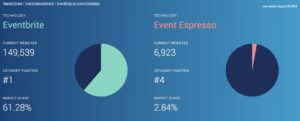
The events industry landscape has changed quite a bit over the last few years thanks to advancements in the software and hardware industry.
Technology has enabled us to automate and manage various event-related tasks which, in turn, help minimize budget and labor constraints. As a result, event organizers are always looking for ways to use modern technology to deliver an amazing event-going experience.
Conference organizers know how important it is to implement technology in their event organization and management practices. It helps them boost audience engagement, measure event performance, and gather helpful feedback to better plan future events.
In this article, we’ll take a closer look at some popular event technologies you can use to improve the attendee experience and optimize your event management efforts.
#1: Online Event Registration and Ticketing
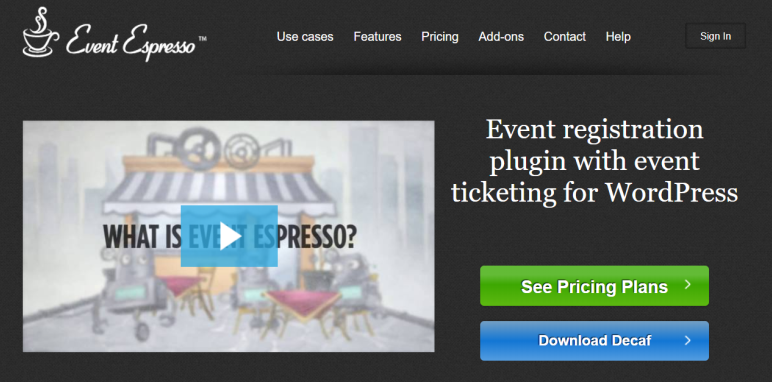
There are many benefits of using an online registration and ticketing system to organize your conference events. For starters, it allows attendees to register and purchase tickets directly from your website.
An event registration and ticketing solution can help you automate event-related processes including offering different types of tickets and keeping track of attendees and ticket sales. In addition to this, you can collect audience feedback by setting up surveys and polls.
Event Espresso is an event ticketing plugin that lets you plan and organize successful events. It’s flexible and easily adaptable to all of your conference event registration and ticketing needs.
It allows event organizers to easily manage every aspect of their event and automate just about everything. With Event Espresso, you can easily gather all of the data you need from attendees by publishing a custom event registration form on your event site.
Plus, you can manage attendee information including which person registered, the event they registered for, and the amount they paid. It also lets you communicate with attendees collectively or individually.
Alternatively, if you do not have a WordPress website you can use Event Smart, which is a hosted SaaS solution for event registration management.
#2: RFID-Based Meal Management

As a conference organizer, you need an online meal management system to help you automate food allocation for attendees and staff, save time and money, and reduce food waste.
Grub Stub is an automated meal management platform that gives you better visibility into the kitchen so that you can plan for your conference’s catering requirements more accurately. It does this by letting you electronically track meal data all the way from the planning phase leading to your live event and post-event activities. This way, you don’t have to manually create meal tickets. Put simply, Grub Stub makes meal management efficient and more accurate.
It’s an online solution that gives you insight into why meals go uneaten and helps you accurately estimate future allocations. This allows you to minimize the negative impact on your event budget.
Grub Stub has a user-friendly interface that helps you handle meal planning, delivery, and billing. You can easily set meal limits, issue scannable RFID passes that serve as a meal ticket, and manage large collection orders with a minimum amount of time spent on administration.
#3: Experiential Analytics

You need an experiential analytics solution that gives you accurate and deep insights into your conference events in order to improve your return on marketing investment. For instance, analytics reports can help you learn about how visitors interact with your conference event.
Exposure Analytics is a powerful experiential analytics tool for events that collects unique metrics about the movement and interaction of your visitors. It comes with a user-friendly intelligent sensor system that’s capable of providing easy to understand analytics for conference events.
Exposure Analytics works by counting visitors in a particular location and monitors entry and exit points using Apex Sensor. Its Aperture Sensor uses facial and mood detection software to gauge the demographic profile and sentiment of your visitors. And its powerful EX Sensors help you gather data about footfalls, engagement rates, dwell times, flow routes, and heat maps at your events.
You can view analytics reports about age, gender, and emotional demographics data for visitors that engaged with your events. Its easy-to-use dashboard lets you quickly view information about new and returning visitor counts, conversion ratio, a live heat map of visitor distribution, and current capacity.
Using Exposure Analytics, you can gather real-time insights about your events and quickly respond to any issues. Plus, you can use this information to plan better events and experiences for your event attendees in the future.
#4: Live Q&As and Surveys
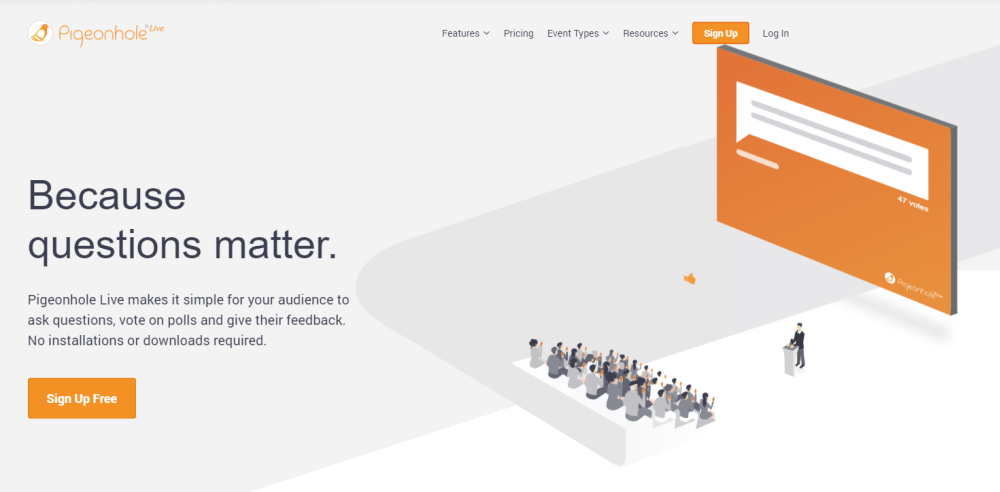
You should make it easy for attendees to ask questions during the conference event and give them the option to vote on polls and provide feedback.
Pigeonhole Live lets you offer event attendees a simple way to submit and vote on questions and generates audience responses for you in both PDF and Excel formats. You can also collect poll votes and generate live charts.
Its Interactive Agenda feature shows information about your event speakers and keeps the audience informed about event activities. This ensures that your audience stays engaged and drives meaningful conversations throughout the conference. An informed audience is able to ask constructive questions and provide helpful feedback.
The Live Q&A feature allows conference attendees to ask questions anonymously in real-time, helping you boost audience engagement. This way, participants can provide honest feedback, enabling you to gauge audience consensus.
Its Live Polls feature offers a fun and collaborative environment to your conference attendees by enabling them to vote on different questions. It also gives you a simple way to get useful insights and quickly follow up with them.
#5: Remote Simultaneous Interpreting
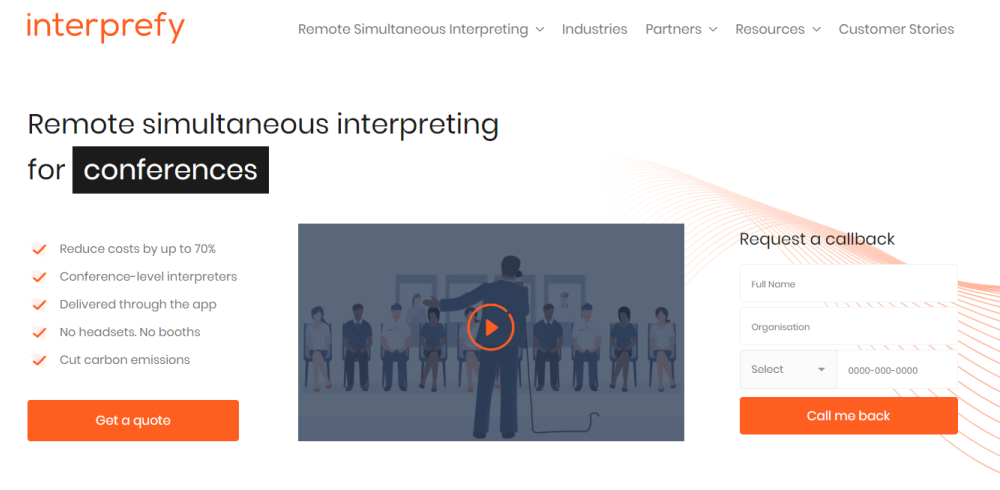
Companies organizing international conferences often need to cater to a multicultural or multilingual audience. However, it can be expensive for some businesses to order translation booths or book interpreters.
Conference events need remote simultaneous interpreting as it gives the meeting a more private and confidential character. Remote simultaneous interpreting refers to translating what is said, while it is being said.
Interprefy is the perfect solution for businesses that are looking for a user-friendly and affordable way to bring remote simultaneous interpretation to their conference events. It’s a cloud-based platform that utilizes the services of language service providers to offer high-quality video interpreting for any language, regardless of the size and location of the event.
Its Event Management Center lets you easily create and manage events as well as moderate and manage speakers and moderators. Interprefy offers a simple and intuitive interface that seamlessly connects speakers and moderators from any place.
Additionally, conference attendees can access interpreted audio through a free iOS or Android app or via a web browser or traditional radio receiver. This means attendees can use interpreted services whether they’re remotely located or present on-site.
#6: Hardware Technology
Let’s take a look at why hardware technology is great for conference events:
- Boosts audience engagement. Technology helps you engage event participants who may feel hesitant about speaking to a crowd. It also opens up new levels of interaction apart from verbal communication.
- Adds visual appeal to the event venue. A high-quality and consistent audio/visual experience is essential for making your events successful. Event technology makes the venue stand out and helps you deliver a memorable event-going experience.
- Great way to get your message across. It helps you communicate with attendees using different mediums. Event technology makes the learning experience intuitive and interactive.
Here are some of the examples of neat event hardware technology you can use to improve your event experience:
Taggbox

Taggbox is a social tool that helps you boost audience engagement using an event social media wall. It offers integration with a number of social platforms such as Facebook, Instagram, Twitter, and RSS to deliver an endless flow of user-generated content.
It works by collecting live content from social media using hashtags and accounts from social sites and delivering it to your venue screens.
Taggbox comes with a number of customizable themes to match your brand colors and event theme. Additionally, it generates useful analytics reports about your event’s social presence and lets you make important announcements.
Giant iTab
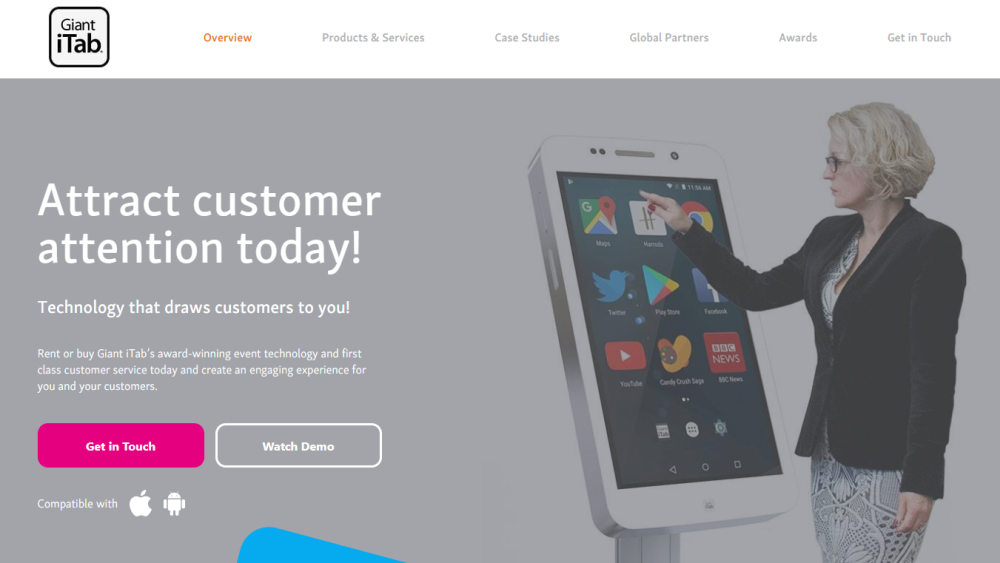
Giant iTab works as an information point that helps you capture audience attention. It makes it easy to demonstrate event technology apps and video content or allow attendees to scroll through interactive sales presentations.
Giant iTab offers an intuitive and user-friendly experience and enables companies organizing conferences to display any of their digital content.
Array

Array is an end-to-end technology solution that helps you boost audience engagement, gather data, and improve your conference events.
It gives you the tools you need to customize event resources such as slides and videos, make changes to your presentations, and boost audience response rates by conducting live polls, Q&A sessions, surveys, and games.
Array helps you measure the performance of your events, gather audience feedback, and share it with your team members as a downloadable report. It also enables you to interact with attendees located remotely across the globe.
Conclusion
Organizing conference events can be made easier using modern technology that helps you get in touch with your audience, manage event registrations and ticketing, and gather valuable feedback. As a result, you’re able to plan better events, improve attendee satisfaction, and boost event attendance.
What event management software do you use to organize your events? Let us know by commenting below.
